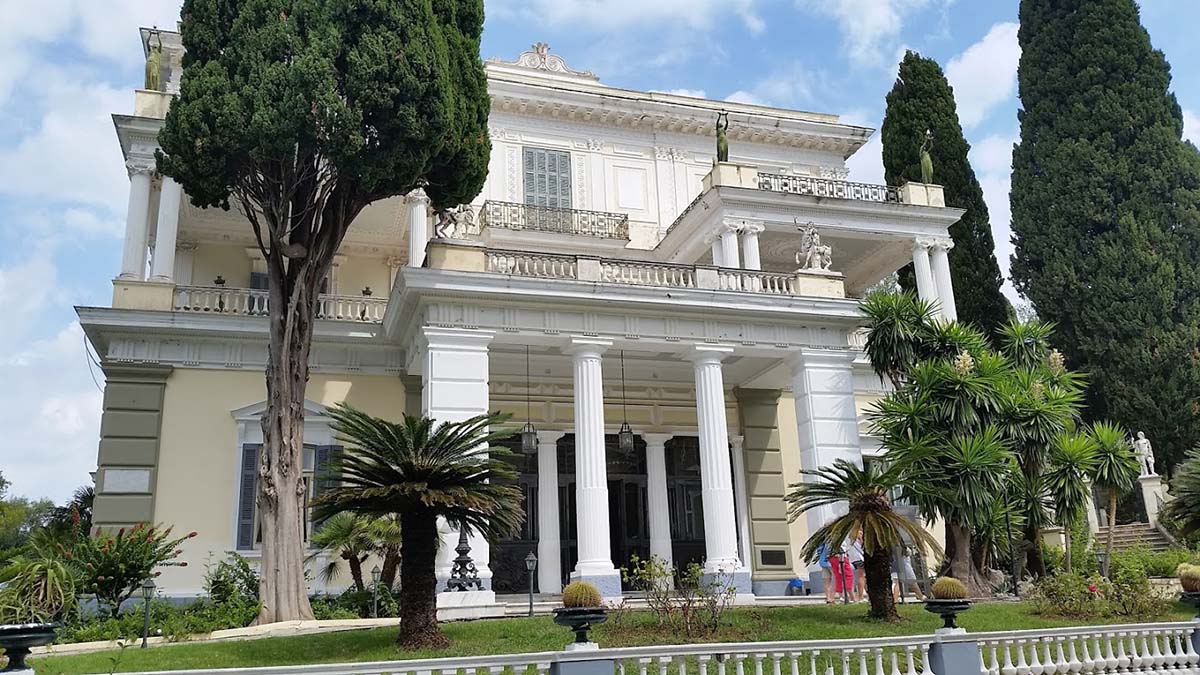
by Ruth Kozak
I’m standing in a beautiful courtyard overlooking a panoramic view of flowering gardens, a green forested hillside and far below, the sparkling blue Ionian Sea. Surrounding me stand the Muses: all nine of them. I’m next Erato, the Muse of poetry. Beside her Terpsichore holds her harp and Melpomine smiles silently. This is the magnificent peristyle of the Achilleion Palace, once the home of Elisabeth, Empress of Austria and Queen of Hungary. The peristyle is dominated by the nine marble Muses together with states of Apollo and the three Graces.
Elisabeth, known fondly as “Sisi” was the daughter of Duke Max of Bavaria and his wife Ludovika. As a child she was shy and not considered pretty but she grew to be a vibrant, attractive young woman who shared a love of the ‘lower classes’ with her father, and enjoyed long walks and horseback riding. At the age of sixteen she became the wife of the Emperor Franz Joseph of Austria and was named Queen of Hungary and Bohemia. However, Franz Joseph, it seems, was a ‘mama’s boy’ and clung to his own mother, who took over the care of the couples two daughters, Sophie and Gisela, who were kept in a nursery near the grandmother’s apartments and raised by attendants chosen by their grandmother.
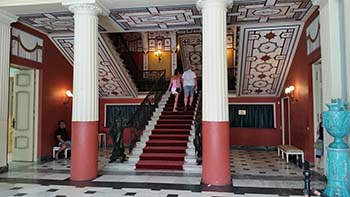 Sisi had little part in their upbringing and almost no contact with the little girls, but during a state visit to Hungary she insisted that the children accompany her. Unfortunately, they became ill and little Sophie died. This misfortune was used by Sisi’s mother-in-law as proof that the young Empress was unfit to be a mother. Her eagerly awaited son, the Crown Prince Rudolf was born a year later but he was also taken into to the care of his grandmother. A third daughter, Marie Valerie was born in 1868 and unlike with the first three children, Elisabeth insisted on raising Mari Valerie herself.
Sisi had little part in their upbringing and almost no contact with the little girls, but during a state visit to Hungary she insisted that the children accompany her. Unfortunately, they became ill and little Sophie died. This misfortune was used by Sisi’s mother-in-law as proof that the young Empress was unfit to be a mother. Her eagerly awaited son, the Crown Prince Rudolf was born a year later but he was also taken into to the care of his grandmother. A third daughter, Marie Valerie was born in 1868 and unlike with the first three children, Elisabeth insisted on raising Mari Valerie herself.
Her only son, Crown Prince Rudolf, was never close to her when he was growing up although he shared her liberal, anti aristocracy, republican beliefs. He was a precocious, delicate young man who feared military training. He’d had an even worse relationship with his father who had refused to allow him to attend university Despondent and rejected, he and his 17-year-old mistress had committed suicide in his hunting lodge. Elisabeth blamed herself because she had not shown him more support. From the time of his death, she wore mourning clothes for the rest of her life.
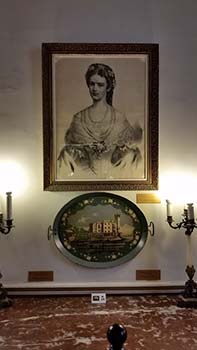 After the wedding of her youngest daughter in 1890, Elisabeth started spending more time away from Vienna. Following a visit to Corfu she decided that this was a perfect location for her to build a palace. The design was meant to represent an ancient Phaecian palace. It was designed by Italian architect Raffaele Caritto and built on a 200,000-square metre area that Elisabeth’s husband had owned. Ernst Herter, a famous German sculptor was commissioned to create works inspired from Greek mythology such as his famous sculpture, Dying Achilles, that forms the centrepiece of the Achilleion Gardens. She also had a cenotaph in memory of her son placed in the Achillean garden which she was able to see from the peristyle.
After the wedding of her youngest daughter in 1890, Elisabeth started spending more time away from Vienna. Following a visit to Corfu she decided that this was a perfect location for her to build a palace. The design was meant to represent an ancient Phaecian palace. It was designed by Italian architect Raffaele Caritto and built on a 200,000-square metre area that Elisabeth’s husband had owned. Ernst Herter, a famous German sculptor was commissioned to create works inspired from Greek mythology such as his famous sculpture, Dying Achilles, that forms the centrepiece of the Achilleion Gardens. She also had a cenotaph in memory of her son placed in the Achillean garden which she was able to see from the peristyle.
From the courtyard of the Muses I walk down the marble steps into the lush garden. In front of me is the magnificent life-sized sculpture of the dying Achilles, his eyes gazing skyward as if supplicating help of from Olympus. Around me are flowering bushes and palm trees, the solitude broken by the chirring of birds. At the foot of the garden there’s an imposing bronze statue of Achilles standing guard surrounded by palm trees. He’s wearing full hoplite armour and brandishing a sword. This statue was commissioned after the Achilleion passed to the ownership of Kaiser Wilhelm in 1907. He also placed a life-size statue of Elisabeth in the garden in her memory.
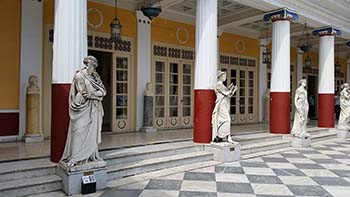 That morning I spent browsing the ornately decorated rooms of the palace. Empress Elisabeth loved Greece, its language and culture and the palace was designed with the legendary hero Achilles as its central theme. She admired the Troy hero and said: “I want a palace pillared with colonnades and hanging gardens, protected from prying glances – a palace worthy of Achilles who despised all mortals and did not fear even the gods.”
That morning I spent browsing the ornately decorated rooms of the palace. Empress Elisabeth loved Greece, its language and culture and the palace was designed with the legendary hero Achilles as its central theme. She admired the Troy hero and said: “I want a palace pillared with colonnades and hanging gardens, protected from prying glances – a palace worthy of Achilles who despised all mortals and did not fear even the gods.”
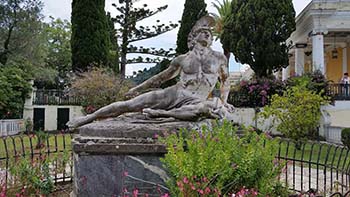 The palace abounds with Classic Greek statues and paintings honoring Achilles. As you enter, there is a staircase with statues of Zeus and Hera. On the right is a portrait of Empress Elisabeth was regarded as one of the most beautiful women in Europe. The ceiling is decorated with a beautiful fresco depicting the “Four Seasons” The upper level of the Main Hall is dominated by a famous painting “The Triumph of Achilles” by Franz von Matsch. In it Achilles is seen dragging Hector’s lifeless body in front of the Gates of Troy.
The palace abounds with Classic Greek statues and paintings honoring Achilles. As you enter, there is a staircase with statues of Zeus and Hera. On the right is a portrait of Empress Elisabeth was regarded as one of the most beautiful women in Europe. The ceiling is decorated with a beautiful fresco depicting the “Four Seasons” The upper level of the Main Hall is dominated by a famous painting “The Triumph of Achilles” by Franz von Matsch. In it Achilles is seen dragging Hector’s lifeless body in front of the Gates of Troy.
The Empress’s Catholic chapel is one of the most impressive rooms with its dome-shaped ceiling depicting the Trial of Jesus. In another room known as the “Arcade of the Wise Men’ there are thirteen busts of ancient philosophers and one of Shakespeare.
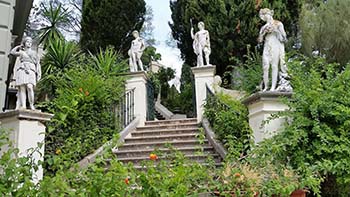
I wandered into Elisabeth’s room where there is memorabilia and paintings of the Empress and her husband together with records from her assassination. After the wedding of her third daughter, Maria Valerie, the Empress had started to travel, usually under an assumed name. Tragically, during an overnight stay in Geneva, 1898, her presence in the city was announced in the newspaper. As she was walking from her hotel to her ship on which she was to leave for France, she was accosted by an Italian anarchist, Luigi Lucheni, who had come to Geneva with the intention of assassinating the Prince of Orleans. When the Prince failed to arrive, Lucheni chose her as his victim, in spite of knowing, nor caring that she shared his opinions on aristocracy. He stabbed her with a sharp file puncturing a tiny hole in her heart that went un-noticed until she later fainted from loss of blood and it was too late for the doctors to save her life. Luchini was sentenced to life in prison but hanged himself in 1910. After Elisabeth’s death the Achilleion stayed closed for nine years until it was sold by her daughter who had inherited it, to the German Emperor Kaiser Wilhelm II.
As I stand in front of the marble statue of Achilles, dying of the mortal wound to his heel inflicted by Paris, I think of this brave, beautiful woman who had such a zest for life and a love of nature and art who so tragically died by an assassin’s hand. I have been inspired by the beauty she created here at the Achilleon and feel privileged to have been a ‘guest’ in her sanctuary with the Muses and her hero, Achilles.
If You Go:
About the Achilleion:
The palace became a centre of European diplomacy until the outbreak of World War I when it was used as a military hospital by the French and Serbian troops. After the war ended, it came into the possession of the Greek State as part of the war reparations in 1919. From 1921 to 1924 the palace housed the Save the Children Fund orphanage. During the years 1941-1944 the palace was used by the Italian and German occupation forces as a military headquarters, but at the end of the war was returned to the Greek State. In 1962 the Achilleion was leased out, and the upper floors were turned into a casino. The casino scene in the James Bond film For Your Eyes Only was filmed at the Achilleion. By 1983 the palace came under the management of the Greek Tourism Organisation and was restored to a museum and used for the European Union Summit. Ever since, the Achilleion has been used as a museum and a venue for various events.
How to get to the Achillion, Corfu
About the author:
W. Ruth Kozak is a travel journalist and historical fiction writer and the former editor/publisher of Travel Thru History. She loves to visit Greece and enjoys writing about the history of that beautiful country. Ruth’s historical novel about the fall of Alexander the Great’s dynasty SHADOW OF THE LION, is available in two volumes on Amazon.com – SHADOW OF THE LION: THE FIELDS OF HADES and in its entirety as a Kindle ebook
.
All photos by W. Ruth Kozak






Leave a Reply
You must be logged in to post a comment.